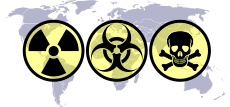Argentina and weapons of mass destruction
| Weapons of mass destruction |
|---|
 |
| By type |
| By country |
|
| Proliferation |
| Treaties |
|
Argentina has a history with the development of weapons of mass destruction. Under the National Reorganization Process, Argentina began a nuclear weapons program in the early 1980s, but this was abolished when democracy was restored in 1983.
Missile systems
During the 1980s, the Alacrán (English: Scorpion) and Cóndor 2 (English: Condor) missiles were developed.[1] The Cóndor 2, with a range of around 1,000 kilometres,[2] was reportedly scrapped during the Menem administration under pressure from the United States government.[3]
Biological and chemical weapons
Argentina acceded to the Geneva Protocol on May 12, 1969[4] and has been active in non-proliferation efforts, ratifying the Biological Weapons Convention in 1979[5] and the Chemical Weapons Convention on October 2, 1995.[6]
In September 1991 Argentina, together with Brazil and Chile, signed the Mendoza Declaration, which commits signatories not to use, develop, produce, acquire, stock, or transfer—directly or indirectly—chemical or biological weapons.[7]
Nuclear weapons
Argentina conducted a nuclear weapon research program during the National Reorganization Process regime. Government officials at the time confirmed, in November 1983, that research carried out at the Balseiro Institute's research reactor had yielded the capacity for weapons-grade uranium enrichment.[8] The program was abandoned, however, shortly after the return of democracy, on December 10, 1983. In 1991 the parliaments of Argentina and Brazil ratified a bilateral inspection agreement that created the Brazilian-Argentine Agency for Accounting and Control of Nuclear Materials (ABACC) to verify both countries' pledges to use nuclear energy only for peaceful purposes. On February 10, 1995, Argentina acceded to the Non-Proliferation Treaty as a non-nuclear weapon state. Argentina continues to use nuclear power in non-military roles, and is noted as an exporter of civilian use nuclear technology.
In 2010, the government announced that it would start working in the creation of a nuclear submarine.[9] Those types of submarines only use atomic energy for propulsion. The announcement was highly criticized by politicians from opposing parties.[10]
In accord with three presidential decrees of 1960, 1962 and 1963, Argentina supplied about 90 tons of unsafeguarded yellowcake (uranium oxide) to Israel to fuel the Dimona reactor, reportedly creating the fissile material for Israel's first nuclear weapons.[11]
See also
References
- ↑ Joseph Cirincione; Jon B. Wolfsthal; Miriam Rajkumar (December 2011). Deadly Arsenals: Nuclear, Biological, and Chemical Threats. Carnegie Endowment. pp. 388–. ISBN 978-0-87003-288-2.
- ↑ Etel Solingen (9 February 2009). Nuclear Logics: Contrasting Paths in East Asia and the Middle East. Princeton University Press. pp. 230–. ISBN 1-4008-2802-3.
- ↑ Robert E. Dundervill, Jr.; Peter F. Gerity; Anthony K. Hyder; Lawrence H. Luessen (9 March 2013). Defense Conversion Strategies. Springer Science & Business Media. pp. 200–. ISBN 978-94-017-1213-2.
- ↑ United States. Congress. Senate. Committee on Foreign Relations (1974). Prohibition of Chemical and Biological Weapons: Hearing Before the Committee on Foreign Relations, United States Senate, Ninety-third Congress, Second Session on Ex. J, 91-2 ... Ex. Q. 92-2 ... and S. Res. 48 ... December 10, 1974. U.S. Government Printing Office. pp. 19–.
- ↑ Jozef Goldblat; Thomas Bernauer (1991). The Third Review of the Biological Weapons Convention: Issues and Proposals : UNIDIR/91/17. United Nations Publications. ISBN 978-92-9045-049-8.
- ↑ Arms Control and Disarmament Quarterly Review. Arms Control and Disarmament Research Unit, Foreign and Commonwealth Office. 1995.
- ↑ Jozef Goldblat (18 November 2002). Arms Control: The New Guide to Negotiations and Agreements with New CD-ROM Supplement. SAGE Publications. pp. 149–. ISBN 978-0-7619-4016-6.
- ↑ National Geographic. August 1986. p.243.
- ↑ Promete Garré que se construirá un submarino nuclear en el país (in Spanish)
- ↑ La oposición, entre las duras críticas y la ironía (in Spanish)
- ↑ "The Israel-Argentina Yellowcake Connection". National Security Archive. George Washington University. 25 June 2013. Retrieved 6 August 2013.
Sources
- "The Nuclear Club: Membership has its kilotons". CBC News Online. April 12, 2006. Archived from the original on 14 April 2006. Retrieved 14 April 2006.
- Nuclear Threat Initiative. "Argentina". Archived from the original on 19 April 2006. Retrieved May 1, 2006.
External links
- The Woodrow Wilson Center's Nuclear Proliferation International History Project Conference on Brazilian and Argentine Nuclear Programs